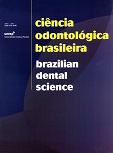Influência da temperatura de sinterização sobre a rugosidade superficial de três porcelanas odontológicas
DOI:
https://doi.org/10.14295/bds.2003.v6i3.619Abstract
O objetivo do presente trabalho foi verificar a influência da variação da temperatura de sinterização na rugosidade superficial em três sistemas de porcelana odontológica. Noventa amostras de porcelana dos sistemas VITA VMK-68, IPS CLASSIC e WILLIAMS foram empregados a três diferentes temperaturas de sinterização: temperatura recomendada pelos fabricantes (R); temperatura 20oC acima (+20oC) e 20oC abaixo da recomendada (- 20oC). Para a observação da rugosidade superficial dos corpos de prova das porcelanas foi utilizado um rugosímetro digital (PRAZIS - RUG 03), realizando seis leituras em cada espécime. Considerando as comparações entre as médias de rugosidade medidas nos três níveis de temperatura a que foram submetidas os três sistemas de porcelana, a rugosidade com a temperatura -20°C foi significativamente mais elevada do que a verificada com a temperatura recomendada e a +20°C, e que a rugosidade obtida com a temperatura recomendada foi também significativamente mais elevada do que a obtida a temperatura +20°C. Isto indica que a temperatura +20°C foi a que se associou com menor índice de rugosidade, independentemente do tipo de porcelana. Pequenas variações na temperatura de sinterização das porcelanas odontológicas resultam em diferentes graus de rugosidade superficial. Os profissionais envolvidos na confecção das restaurações que utilizam porcelanas feldspáticas devem, periodicamente, aferir a temperatura dos fornos utilizados na sinterização, a fim de evitar alterações indesejáveis na sua lisura superficial.Downloads
Downloads
Published
How to Cite
Issue
Section
License
Brazilian Dental Science uses the Creative Commons (CC-BY 4.0) license, thus preserving the integrity of articles in an open access environment. The journal allows the author to retain publishing rights without restrictions.
=================




























